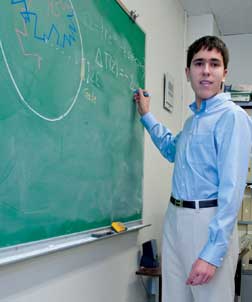Senior Profile/Young Scholar: Graduating from Pitt at 17, Carey Caginalp Already Has the Math World Abuzz
 Carey Caginalp
Carey CaginalpShortly before his 17th birthday last fall, Carey Caginalp, a University of Pittsburgh graduating senior, received exhilarating news. The French Academy of Sciences had accepted an announcement of his first paper for its prestigious Comptes Rendus Matematique, an internationally renowned journal that disseminates significant mathematical discoveries with rapid speed. Caginalp’s research paper, titled “Analytical and Numerical Results for First Escape Time,” described his groundbreaking application of the century-old Brownian motion theory to an embryonic area of applied mathematics.
Identifying a cutting-edge problem in a discipline with roots in antiquity is challenging, according to Xinfu Chen, a professor in Pitt’s Department of Mathematics who supervised two of Caginalp’s independent study courses (vector calculus and methods of applied math) and served as his University Honors College thesis advisor and collaborator. “I have known Carey for a number of years,” said Chen. “He’s very smart, he’s self-disciplined, and he understands what he is learning and the direction he needs to go. I know he has a bright future.”
Caginalp’s fascination with numbers and quantitative measures emerged during his toddler years. “When I was little and my family finished eating dinner, I would run to the basement and watch the numbers on the water meter change as the dishwasher ran,” Caginalp recalled with a smile.
When he was five or six, Caginalp asked his parents—Pitt professor of mathematics Gunduz Caginalp and his wife, Pitt alumnus Eva Caginalp, who earned her master’s degree in applied math here—about “private numbers,” explaining that the number 2 hops onto 4, then 6, then 8, just like the number 3 hops onto 6, then 9, then 12. “But no numbers hop onto number 17,” the youngster explained.
“We knew then that Carey had somehow discovered ‘prime numbers,’” said his father, “but neither of us had taught him about ‘primes,’” integers that can only be exactly divided by themselves and by 1.
Around this same time, Prof. Caginalp recalled, “We bought Carey a book about the planets, which he began to read in the car. After a while, Carey said he couldn’t understand something.”
“The diameter of Mars is about half of the Earth’s diameter,” the youngster told his parents, “but Mars’ mass is tiny compared to Earth’s,” suggesting that Mars was made of much lighter material, which contradicted the book’s description.
“It turned out that the book contained a typo for the mass of Mars,” explained Prof. Caginalp. “More important, my wife and I now knew that it was a good time to officially introduce Carey to the concept of density.”
Born, raised, and home-schooled in Pittsburgh’s Squirrel Hill community, Carey Caginalp was 10 years old when he enrolled in his first Pitt course, “Discrete Mathematical Structures,” through the University’s Accelerated High School (AHS) program. Not surprisingly, he earned an A+.
Jackie Batt, who directs Pitt’s AHS and College in High School programs, has seen less than a handful of 10-year-olds enrolled in college courses during her almost 20 years at the University. “Carey is delightful!” she exclaimed as she described the young man who will join the other members of the Class of 2011 during Pitt’s graduation ceremonies today. “He’s polite, well-rounded, and mature,” she added, “and he has done extremely well here.”
Among his list of honors and awards is the 2010 Pitt Department of Mathematics Culver Prize, awarded for excellence in math, and a 2010 Brackenridge Summer Research Fellowship, named in honor of Pitt’s founder—Hugh Henry Brackenridge. Brackenridge fellows are selected on the basis of their academic records and the originality and promise of their proposed projects, as well as their aspiration to both create and participate in an interdisciplinary community of students in the humanities, social sciences, natural sciences, and applied disciplines. Young Caginalp made the cut and under the guidance of his faculty sponsor, Professor Chen, began his ambitious research in an area with far-ranging implications.
The tall, lean Caginalp presented this work last summer at the 2010 annual meeting of the Society for Industrial and Applied Mathematics and again in the fall during Pitt’s Applied Analysis Seminar. He also submitted a second paper to the Archive for Rational Mechanics and Analysis, which provides full publication for research of exceptional moment, depth, and permanence.
This summer, when he’s not playing tennis or golf, Caginalp will be furthering his work with support from Prof. Chen’s National Science Foundation’s (NSF) research grant. In August, Caginalp will embark upon another leg of his incredible 17-year journey as he leaves the “City of Champions” to begin his PhD program in applied mathematics at Brown University in Rhode Island, thanks to a recently announced competitive award he received from the NSF’s Graduate Research Fellowship Program (GRFP), which recognizes outstanding students in NSF-supported mathematics, science, technology, and engineering disciplines who are pursuing research-based master’s and doctoral degrees at accredited U.S. institutions. The GRFP will provide the young scholar with a $30,000 stipend a year for three years, plus full tuition and fees.
Other Stories From This Issue
On the Freedom Road

Follow a group of Pitt students on the Returning to the Roots of Civil Rights bus tour, a nine-day, 2,300-mile journey crisscrossing five states.
Day 1: The Awakening
Day 2: Deep Impressions
Day 3: Music, Montgomery, and More
Day 4: Looking Back, Looking Forward
Day 5: Learning to Remember
Day 6: The Mountaintop
Day 7: Slavery and Beyond
Day 8: Lessons to Bring Home
Day 9: Final Lessons

